Top 20 Cubs prospects: 2021 preseason
Prospect rankings are a living, breathing organism. Upon publishing, they become a snapshot of what a player’s performance has been and what the details of that performance say about where a player is going. As new information and new players emerge, predictions contract and swell.
For the majority of prospects, the COVID-19 pandemic put a cap on the gathering of new information. Even for scouts, whose job it is to analyze and project, that information has sometimes come in modified forms. Video and data sharing from alternate training sites was optional. And as most scouts will tell you, if your primary form of information gathering or updating for a report is video, there is a lot that won’t be captured.
There is perhaps no other point in time where this long of a layoff from competitive games has occurred for nearly all prospects. As a result, this season will present a massive recalibration for the majority of prospects in baseball. Players will have matured, pitches designed, swings changed and ceilings moved. And if prospect lists are a snapshot of a point in time, this moment is one of the most confounding we’ve possibly ever had.
With that in mind, below is my interpretation of the Top 20 prospects in the Chicago Cubs farm system, based on performance and the opinion of multiple pro scouts across the league.
Terminology key for reference:
Plus-plus = two standard deviations above the major league average, “70 grade”
Plus = one standard deviation above the major league average, “60” grade
Above average = between major league average and plus; “55” grade
Average = the major league average; “50” grade
Below average = between major league average and one standard deviation below the major league average; despite sounding pessimistic, this could still mean the skill is better than 30-40% of major leaguers; “45” grade
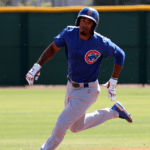
1. Brennen Davis – OF
Davis is the crown jewel of the Cubs system. There is no other player in the organization with his combination of tools across the board. He has a chance to be an above average hitter with above average game power that can develop to plus. This equates to something around a .270 hitter with 27 home runs with potentially more in the tank. His speed, glove and arm are all future average to above average tools.
The reason for Davis’ stock uptick in recent years comes primarily from the combination of performance and body maturation. He hit .305 with a .525 slugging percentage at Class A South Bend in 2019 (widely considered a league that favors pitching) at just 19 years old. In both of his first pro offseasons, he added good weight to his 6-foot-4 frame, allowing many to project more in-game power without a significant drop to his mobility and thus a hit to his defensive profile.
The Cubs organization’s endorsement came last year when they added Davis to the South Bend alternate site amidst the COVID-19 pandemic. He is the kind of prospect that can make a sustained impact at the major league level in the middle of a championship lineup.
More on Brennen Davis: 2020 prospect profile
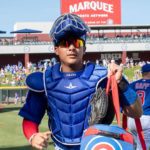
2. Miguel Amaya – C
The idea that Amaya could handle the majority of starts at catcher for the Cubs in 2021 and produce average results in his age 22 season is real. And the future value of an everyday catcher compared to that of other, more tantalizing profiles (think Marquez and Howard), is one that will be perpetually underrated. The grind of the catching position wears heavily for any catcher on their offensive profile. In comparing the average catcher offensively to the average position player, remove about 10 points of average and OBP along with 4-5 home runs.
Amaya has a chance to be a plus defensive catcher with an above average hit tool, an above average throwing arm, and in-game power that should provide 15 home runs per season. His strength at the plate in his career has been getting on base and understanding the strike zone, rather than a contact-first profile. This approach should allow him to get to more of his raw power in game than some players have the ability to do.
If 2020 was a normal season, Amaya would have probably spent the majority of his time at Double-A, which would have set up this season for more development at Triple-A before an eventual debut in the majors. That timeline has become clouded and should clear up as the season progresses and assignments unfold. Expect to see him in spring training again this year, his fourth opportunity since 2017 to take reps with the team’s future big league arms.
More on Miguel Amaya: 2020 prospect profile
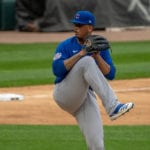
3. Brailyn Marquez – LHP
Marquez’s value depends on whether he is viewed as a starter or reliever long-term. In some realms of analysis, a championship-level closer, like Josh Hader, is equivalent to that of a 3rd starter. Both produce around 3 to 3.5 WAR per season at peak, despite the closer having a greater proximity to high-leverage outs, which are arguably the toughest to get.
In analyzing a prospect like Marquez, you have to consider all the possibilities. The departures of Yu Darvish, José Quintana and Jon Lester have opened up space for a pitcher like Marquez to mature in the role of a starting pitcher. Although his one appearance at the major league level last season turned out rocky, he showed a strong level of comfort with his changeup. This suggested his path to three viable pitches — fastball, slider, changeup — as a starting pitcher and knocked off one concern about his future role (the other being his ability to fill up the strike zone).
If he doesn’t work out as a starter, his profile as a reliever is strong. The sample of pitchers with his velocity from the left side at just 21 years old is infinitesimal. His slider is already average with time being the only stopgap to plus. And his history working as a starting pitcher opens the door to a multi-inning relief role that has become popularized in recent years.
More on Marquez: 2020 prospect profile
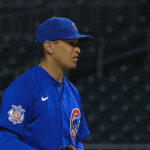
4. Adbert Alzolay – RHP
The term “upside” is used heavily in the space of public analysis to denote a player who has a chance to become more than they are at present. The term is heavily overused and leaves out important context. Every player possesses upside. One job of a team’s player development is to realize as much of that upside as possible.
Thanks to an investment in technology and individuals — like Craig Breslow and Justin Stone — the Cubs have effectively turned the tech’s output into actionable goals. Alzolay’s 2021 season may be the first reward of this enhanced ability to realize as much of a prospect’s potential as possible.
After a promising debut in 2019, Alzolay produced a 2.95 ERA in 21.1 innings in 2020 with peripherals like a 33% strikeout rate that support his performance as more than a blip. The fundamental change for Alzolay was the addition of a two-seam fastball prior to 2020 and creating a distinct difference in movement profile between his slider and curveball midway through the fanless season. This has propelled Alzolay from a future 5th starter to more of a 3rd or 4th starter and gave him the inside track to earn a spot in the 2021 rotation.
More on Alzolay: Deep dive on his slider
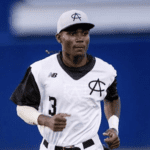
5. Ed Howard – SS
Howard is one of many players on this list who has no reps at a professional level or instructional league in the past year. Even with that in mind, his pedigree out of Mount Carmel High School in Chicago is enough to warrant a Top 5 rank. Numerous outlets, under the influence of the league’s best amateur scouts, ranked Howard as a Top 15 draft prospect and a consensus Top 4 talent among 2020 high school prospects. The Cubs seemed to agree, selecting him 11th in last year’s First-Year Player Draft.
There have been strong indications across the amateur showcase circuits prior to Howard’s draft year that he will stick at shortstop long term. Although he is just 18 years old and could grow into his present 6-foot-2 frame, his present athleticism grades out as plus-plus per FanGraphs, the highest mark of any position player drafted inside the top 50 last year. The wild card in his profile is his bat. Howard doesn’t have 1/4th the amount of reps a third-year college bat would have — like Chase Strumpf or Nico Hoerner — which leaves open the possibility for grade jumps on his hit tool and in-game power as graduates to face major league secondaries. This would be similar to what transpired with Davis after being drafted–add good weight, show an adept approach against quality arms and a player’s stock will jump. If the Cubs player development succeeds in actualizing Howard’s potential, the sky is the limit.
More: How Heyward is mentoring Howard on and off the field
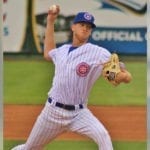
6. Kohl Franklin – RHP
This rank of Kohl Franklin might be the most aggressive in the industry. It ties directly to the value Cubs player development has extracted out of players like Alzolay under Craig Breslow and how vice president of player development Matt Dorey spoke of Franklin’s improvements since February 2020.
Franklin’s fastball sat 90-93 and topped out around 95 in 2019 with what some consider the organization’s best changeup. Indications are that Franklin has added some velocity in the past year that would place him around 93-95 mph and top out around 97. If that is confirmed this season and the Cubs can create an average to above average curveball from his naturally high raw spin on the pitch, Franklin could be the best starting pitching prospect in the organization by the end of 2021.
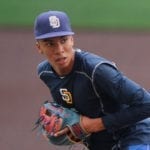
7. Reginald Preciado – SS,3B,OF
Preciado is the centerpiece of the Yu Darvish trade. Because of the depth of the Padres farm system, a player like Preciado does not receive as much media attention as flashier names. But Preciado’s performance at the Fall Instructional League in Arizona for the Padres in 2020 impressed. He is a switch hitter with a future average hit tool — an endorsement for a 17-year-old — and a simple swing from either side of the plate. Some expect growth into his 6-foot-4 frame that will move him off of shortstop, which is why we indicate Preciado is a 3B/OF. But with that potential defensive move comes the expectation of more strength and power.
The question is how his offensive profile will round out. He could become a free-swinging, hit-over-power type bat with a consistently high quality of contact, or he could add enough power to become a .260 hitter with 20 home runs. His offensive standard will increase if he does move off of shortstop, unlike Howard’s — who many expect to stick at short. If all breaks correctly, Preciado and Howard on the left side of the infield with complementary offensive profiles by 2024 would be a strong testament to the Cubs’ offensive player development.
More on Reginald Preciado: VP player development Matt Dorey’s thoughts
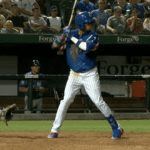
8. Christopher Morel – 3B
The combination of Morel’s strong, wiry frame and lightning-quick hands are exciting. Next to Davis, these characteristics allow Morel to consistently make some of the loudest contact in the organization. He will most likely be a power-over-hit type of offensive profile, which means there could be some more strikeouts in tandem with big homers, but this offensive profile fits at third base or in a corner outfield spot, which is an endorsement of his bat.
Good prospects hit mistake fastballs and are able to produce average or even slightly below average results against major league secondaries. The best prospects show flashes of managing both even at lower levels. Often that gap between good and great comes down to intangibles like a player’s makeup. For organizations and scouts alike, this is one of the most difficult characteristics to understand as it can’t be distilled to an objective number (although some organizations have probably tried). Morel’s ability to hit major league quality secondaries at higher levels of the minor leagues and how the Cubs help him develop that approach will indicate where he’ll fall on the offensive spectrum. His makeup, which has drawn rave reviews from inside and outside the organization, could be a variable that skyrockets his future value.
More on Christopher Morel: 2020 prospect profile
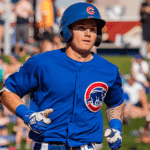
9. Cole Roederer – OF
Roederer, Morel and Davis shared the top of the South Bend Cubs order in 2019. Roederer has a better hit tool than Morel, but his in-game power is something that lags behind Morel’s profile. Most of the power he gets to in-game is to his pull side. For Roederer, the expectation isn’t for him to start spraying home runs all over the field, but rather spraying doubles into the gaps and avoiding the inclination for teams to shift outfielders at the major league level to limit the effectiveness of his pull-side power. If he were to max out his offensive profile, it would probably mean even more power through more weight and probably a move off center field — not necessarily a bad thing at all if his offense becomes his carrying tool.
Roederer primarily played center field for South Bend, with Davis manning right field. His mobility and glove are average, which suggests he could play center field at the major league level, but that would be in the role of a strong-side platoon if he struggles to hit left-handed pitching.
More on Cole Roederer: Prospect Profile
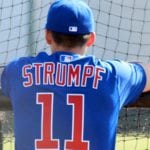
10. Chase Strumpf – 2B
Strumpf was a late addition to South Bend in 2019 after being drafted and playing 30 games at Rookie Level and short-season Class A. His hit tool projects as one of the best in the system, if not already the best at present. This is due in part to his age — he turns 23 this March — and track record across three seasons of play in the Pac-12 with UCLA. He hit .297 with a .409 OBP in 176 college games, combining for 21 home runs in his sophomore and junior seasons.
Strumpf should move through the minors quickly. If the 2020 season proceeded as normal, 2021 would have probably seen Strumpf taking reps with Triple-A Iowa. His glove and speed are average, which makes the big development question how much power he can tap into. His swing is compact and refined, similar in style and effectiveness to Hoerner. But if his .600+ SLG during his sophomore season at UCLA can bubble to the surface more often, he could be more of an impact bat at the major league level. Regardless of his power development, it would not be surprising to see Strumpf have some sort of role in the major leagues by the end of the 2022 season.
More on Chase Strumpf: Prospect Profile
11. Ryan Jensen – RHP
Jensen broke out at Fresno State during his junior season in 2019. He posted a 2.88 ERA with a 1.07 WHIP as a starting pitcher across 100 innings. The Cubs sent their 2019 first-round pick to short-season Class A after for 12 innings before shutting him down. 2020 would have probably seen Jensen throw close to 130 innings and potentially push up to Double-A by the end of the year, but the COVID-19 pandemic rendered any hopes of quick progression moot. Instead, the Cubs brought Jensen to the South Bend alternate site with other top prospects to keep him on track as much as possible.
Jensen is squarely the 3rd or 4th best pitching prospect in the system. He possesses a fastball that has topped out at 99 mph and a slider and changeup that both have projected in the past to be average pitches. His secondaries connect back to a theme in Cubs player development and pitch design in general: how can the organization improve what a pitcher is already comfortable doing rather than changing a lot to rewrite how a pitcher operates? It’s easy to imagine an arm with myriad tweaks to their offerings, but the complexity in most pitch design programs is changing a player to maximize the potential of what they currently throw.
If the Cubs can increase the quality of either secondary Jensen throws – like they did with Alzolay’s breaking balls and we expect them to do with Franklin’s curveball – his stock would increase. Even if there’s some relief risk, his history starting in college should turn his floor into a quality multi-inning reliever.
12. Cristian Hernandez – SS
The international market routinely produces some of the best players in baseball. The majority of which are signed as shortstops and then moved off the position as their bodies mature and future athleticism comes into focus. The Cubs have said Hernandez projects to be a shortstop long term, adding to what has become a trove of shortstop prospects in the last calendar year. At present, his bat is expected to showcase more strength as a contact hitter than a power producer, but it would not be surprising if this profile changes with time. The industry will have a better gauge on Hernandez’s talents as he comes stateside this year or next, but the expectations are high.
13. Cory Abbott – RHP
Abbott might be best known for throwing a perfect game at Loyola Marymount University in 2017. The Cubs drafted him 67th overall later that summer. Abbott has taken a pretty standard path through the minor leagues since, pitching one year at each level, suggesting 2020 would’ve been his opportunity to log over 150 innings at Triple-A Iowa.
Abbott’s repertoire is based on his secondaries, throwing a slider, curveball and changeup which all grade out as average to above-average pitches. The carrying tool of his profile is his command, which some project to plus. Like most command-based starters, however, Abbott’s velocity is below the major league average. Between Alec Mills and Kyle Hendricks, the Cubs have had success extracting substantial value from this kind of profile.
The Cubs also endorsed Abbott by protecting him from the Rule 5 Draft and adding him to the 40-man roster this winter. With rotation spots open and only minor seasoning needed, fans should expect Abbott to debut sometime this season.
More on Cory Abbott: 2020 prospect profile
14. Ismael Mena – OF
Mena is another project for the Cubs player development to flex its muscles on. If he and Yeison Santana realize the same percent of their maximum potential, Mena’s profile will produce more offensive production on the diamond. Like Preciado and Hernandez, there is an expectation he grows into his 6-foot-3 frame. If that occurs and more power output is the result — think Brennen Davis — he profiles favorably as a power-first corner outfield prospect even if it comes with swing and miss.
Mena will continue to play center as long as the Cubs see fit, similar to how many young prospects stick at short until eventually moving to second or third, depending on their arm strength and offensive profile. There is risk in any 18-year-old prospect, but for Mena, it seems to be commensurate with the potential reward.
15. Riley Thompson – RHP
Thompson falls into the category of Marquez-type prospects, where a balance of the probability he is used as a reliever rather than a starter has to be considered. But he also falls into the category of Franklin-type prospects with a high-spin curveball that could be expected to increase in quality if the Cubs player development can work their magic on him like they have on others.
His fastball-curveball combination comes from his slightly cross-body delivery — think Jake Arrieta — which is one reason why some think he’s bound to be a reliever. But this, like his curveball, is something that could be corrected or improved to work in the context with who he is as a pitcher. If all breaks correctly, the Cubs could have a dual-use weapon, spot starting some games and working in a multi-inning role out of the pen.
16. Keegan Thompson – RHP
Thompson is similar to Abbott in many ways. Both have similar frames and rely on their secondaries to buoy their repertoire with lower velocity fastballs. Thompson underwent Tommy John prior to his junior year in college and missed time in 2019. Upon his return to the mound, he struck out 13 batters across 10 innings with only one walk. All indications are he was fully healthy and ready to attack high-minors hitters in 2020 with his four-pitch mix.
He profiles as a 5th starter with hope for a boost in velocity if he happens to move to the ‘pen down the road. The phrase “you can never have enough pitching,” is something that recent World Series contenders have proven in spades. Thompson is one of the many arms in the upper minors with a chance to prove that point for the Cubs.
17. Yeison Santana – SS
Santana is another piece from the Darvish trade, with a more defense-based profile than Preciado or Mena. His ultimate role at the major league level will come down to how much he hits and whether he sticks at shortstop. Indications are, at the moment, that Santana will play shortstop long term. And players of Santana’s mold have generally found roles at the major league level if they can stick at the position, even if their bat never becomes impact level in the majors.
He joins the likes of Howard, Hernandez and a few honorable mentions as players the Cubs revamped player development will mold into the future of the organization.
18. Burl Carraway – LHP
The Cubs selected Carraway 51st overall in the 2020 First-Year Player Draft, but the bigger endorsement of his talent was sending him to the South Bend alternate site last summer. With Carraway, Marquez and 2020 draftee Luke Little, the Cubs have cornered the market on high-velocity left-handed arms.
Carraway has touched 100 mph in the past, with a curveball that tunnels off the pitch well. He stands only 6-foot, with his velocity a testament to how dynamic he moves for somebody of his size and age (21). With every other pitcher in this top 20, there is some probability of a starting pitcher role, but Carraway has virtually no experience starting games. The Cubs have also expressed their desire to use him as a reliever. For this reason, as discussed in the blurbs about Marquez and other arms, Carraway’s rank is suppressed despite his second-round draft pedigree.
If Carraway’s addition to the alternate site was any indication, he will move quickly through the system with a strong probability of logging high-leverage innings.
More on Burl Carraway: Podcast Appearance
19. Michael McAvene – RHP
McAvene stands 6-foot-3 with a prototypical pitcher’s body. He is similar in future value to an honorable mention pitcher, Hunter Bigge, but McAvene’s use as a starter, even at short-season Class A in 2019 after being drafted, suggests there might be more of a chance for him to work in a multi-inning relief role if he moves to the bullpen. The most beneficial outcome to the Cubs, however, would be to work him as a starting pitcher if he can develop an average third pitch. As of our last update on his skillset, McAvene sports a fastball-slider combo that is a blueprint for how to succeed in the modern era of baseball: throw hard with life, now commonly referred to as “carry” or “ride,” and create above-average movement with a secondary pitch.
20. Ronnier Quintero – C
A catcher, at any level, who possesses the ability to hit above league average for the position and potentially stick behind the plate is valuable. And because of the timetable catchers take to develop, generally underrated by the public. Quintero is only 18 years old, but shows promise as a balanced hit-and-power catcher. His hit tool is the reason why there could be average power for the position despite below-average raw or batting practice power. If he stays behind the plate long term, there’s platoon potential here at the major league level. And Quintero’s left-handed bat would make him the strong side of that platoon. If he actualizes his potential, this would be a big win for the Cubs international scouts and player development.
Honorable Mentions
2020 Draftees: Jordan Nwogu is a raw hitter with a fantastic hit-power combination across three seasons for Michigan. The Cubs have already started tinkering with his unconventional swing by raising the starting position of his hands up above his shoulders. There is nothing little about Luke Little’s velocity. Like Marquez and Carraway, he has touched 100 mph from the left side. Keon Moreno is a hyper-athletic, 6-foot-2 high school pitcher who had a max velocity increase to 94 mph in the fall of 2019.
Reliever-type arms: Justin Steele is a fastball-curveball southpaw with a history of starting. He falls into the Marquez-Thompson mold of his long-term role, starter or multi-inning reliever, having an impact on his future value. Hunter Bigge is a right-handed arm that has eclipsed 97 mph with an above-average breaking ball after departing from Harvard in the 2019 First-Year Player Draft, according to FanGraphs. Manuel Rodríguez ran into a biceps issue in spring training, but he has made a full recovery. He is coming off back-to-back minor league seasons with a strikeout rate of 30% or better.
Shortstop prospects: Luis Verdugo is similar to Yeison Santana in that he has a defense-first profile who will have to stick at the position to keep the bar for his offensive profile attainable. Kevin Made (pronounced MAH-day) is a 2019 international signee that has taken big strides in each of his first two seasons at the fall instructional league. The hope is these improvements stick as he presumably reaches full-season ball this year. In that case, he would be in strong consideration for a top 20 prospect.


